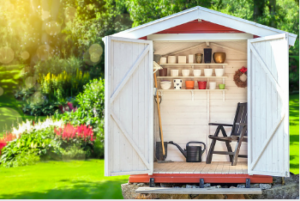Understanding the permit process for custom sheds is crucial in ensuring your project is legally compliant and runs smoothly, eliminating potential roadblocks that can delay construction and increase costs.
Before diving into constructing a custom sheds permit, it’s crucial to understand the need for a permit. Municipalities often require access to ensure safety, adherence to zoning laws, and preservation of property values. You might be fined or compelled to dismantle your carefully constructed shed without a license.
Determining If a Permit is Required
 Not all shed projects require a permit. Factors such as the size of the shed, its location on your property, and its intended use can influence the need for a license. Check with your local building department or regulatory authority to determine specific requirements and avoid surprises.
Not all shed projects require a permit. Factors such as the size of the shed, its location on your property, and its intended use can influence the need for a license. Check with your local building department or regulatory authority to determine specific requirements and avoid surprises.
Applying for a Custom Shed Permit
The permit application process typically requires submitting a detailed plan of your custom sheds permit. This plan should include dimensions, materials to be used, and the shed’s location relative to property lines and other structures. Some municipalities may also require information about the shed’s intended use and its impact on drainage or traffic visibility.
Dealing with Permit Denials
In some cases, your permit application may be denied. Common reasons for denial can include plans that violate zoning restrictions, negatively impact drainage, or pose safety risks. If your application is denied, work with your local officials to understand the reasons and adjust your plans accordingly.
The Aftermath: Inspections and Compliance
Post-approval, you’ll need to ensure your shed’s construction aligns with the approved plans. Expect periodic inspections during the construction process and a final review after completion. Non-compliance can lead to fines and even forced removal of the structure.
Navigating the Permit Process: Beyond the Basics
After gaining a basic understanding of the custom sheds permit, it’s vital to delve deeper into the implications.
Understanding Zoning Laws
Zoning laws can often be intricate and variegated, fluctuating between localities. Familiarize yourself with these specific regulations. For instance, certain zones may restrict the maximum height of accessory structures, while others might stipulate a minimum distance from property lines.
Communicating with Neighbors
While not a formal part of the permit process, discussing your shed plans with your neighbours is courteous and often beneficial. Clear communication can prevent potential disputes and foster a harmonious neighbourhood environment.
Maintaining Your Shed Post-Construction
Securing a permit and complying during construction is only part of the journey. Regular maintenance of your shed is vital to ensure it remains safe and continues to comply with regulations. Failure to maintain your shed could lead to deterioration that may violate safety standards, potentially resulting in fines or forced removal.
Seek Professional Guidance
Navigating the permit process can be daunting and time-consuming. Consider engaging a professional who can guide you through the process, saving time and ensuring your plans comply with all applicable regulations.
Understanding the permit process for custom sheds can seem overwhelming. Still, with careful planning and a proactive approach, you can navigate the steps successfully and enjoy your new custom shed with peace of mind.
Conclusion:
Obtaining a permit for a custom shed is a necessary hurdle that ensures your project complies with local regulations and is built to the highest safety standards. By understanding the permit process, you can navigate it efficiently and enjoy the benefits of your custom shed without legal complications.